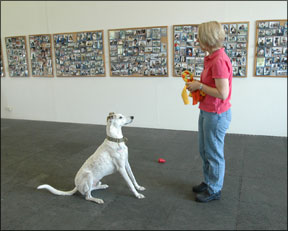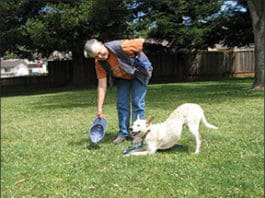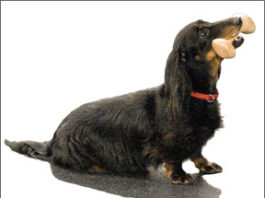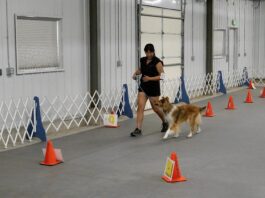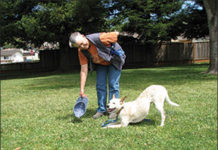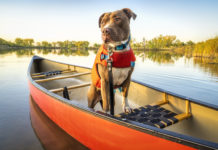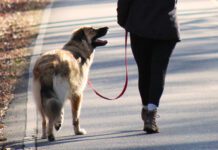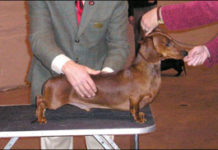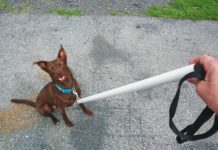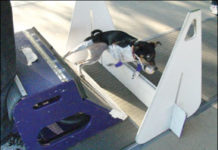Looking for a Fun Trick to Teach to your Dog?
The trick Take a Bow!" is basically an exaggerated play bow
Dog Parkour: Canine Urban Athletes
too! Just about any dog
Canine Sports: Herding Competitions
Fetch. Drive. Flank. Come-bye. Go-bye. Way to me. Outruns. Flight zones. Pressure point. That'll do! The sport of herding has a unique vocabulary that distinguishes it from all the other canine sports. In addition to basic obedience cues such as sit, down, stay, and come, dogs are trained to respond to cues that tell them when to start moving livestock, in which direction to move them, when to stop moving them, when and how to move them into pens, and how to use their physical presence to pressure the stock to move but not to scare them into running or stampeding. There is dirt, there is dust, there is livestock that can break bones and bruise a body, and there is livestock poop. And herding teams love it all.
How To Get Your Dog To Wear A Life Jacket
Vested interests
How to Stop a Dog From Pulling on a Leash
Any chance you’d like to transform your dog walks from frustrating leash-pulling contests of strength to enjoyable and cooperative outings?
How to Train Show Dogs
a positively trained Boxer
Canine Sports: Tracking
The sport of American Kennel Club (AKC) tracking started out as a stepchild to its competition obedience Utility Dog (UD) title. Although you needed to pass a separate tracking test to earn your UD title between 1936 and 1946, tracking garnered a one-paragraph description in the rules and regulations of the time. Fans of tracking pushed for changes in the rules as a result of increased understanding of scent work and, in 1947, tracking became a separate class. The Tracking Dog (TD) title was the only tracking title available until 1980 when the Tracking Dog Excellent (TDX) title was added.
Five Things to do When Your Dog Grabs the Leash and Doesn’t Want to...
The game of leash-tug is encouraged by some agility competitors, as a reinforcer for their dogs at the end of an agility run. However, many dog owners (myself included), find it an annoying and sometimes even dangerous behavior. Here are five things you can do if you're in the latter group and would like to get your dog to stop playing leash tug:
High-Energy Canine Competitions
Woof, yap, scream, yodel, bark, yip. Go, go, go!” Dogs on the sidelines and in crates and exercise pens barking at the top of their lungs. Dogs tugging and growling, tugging and growling. Handlers yelling over the din to their teammates. Handlers recalling their dogs over jumps, H-e-r-e! Event officials blowing whistles and announcing the next race over bullhorns or speaker systems, and start-line lights and passing lights flashing on and off. Flyball is a cacophony of sights and sounds. It is exhilarating, over the top, adrenalized hyperstimulation. This is not a sport for the introverted, timid, or sound-sensitive dog or handler. The adrenalin level is off the charts and you can hear that from hundreds of yards away. The first time I experienced flyball was as a spectator at an obedience trial held at a park. Suddenly, shattering the decorum, was an ear-piercing scream followed by rabid barking. Certain that an obedience dog had left the ring and treed a critter, I raced over to watch. No critter. No mayhem. Just flyball. The teams had just set up for their first race and the dogs were ready. I had never seen dogs so keen to get going.
9 Great Warm Up Games and Exercises for Your Dog
Every dog should be walked at least two to three minutes prior to starting activity. For more strenuous activities, walk longer and include some jogging toward the end. There is no better gait for overall exercise than a brisk walk.
Target-Train Your Dog to Ring A Doorbell
Each month, I stand in the middle of my training center during the second session of my newest Level One class and introduce my...
How to Teach Your Dog to “Search”
The "search me!" game uses lots of energy and can tire out your very active dog, and offers very practical applications as well. Start with treats, since most dogs will happily look for food. You can eventually ask him to look for hidden objects (favorite toys, your lost keys) and even hidden or missing humans!


